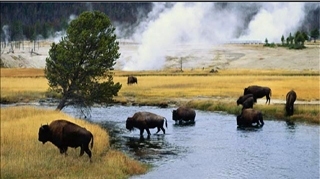A Comparison of Two Primaries: 1916 & 2016
A.
Situation in 1916
President –Woodrow Wilson (Dem) ending 1st
term [Obama (Dem) ending 2nd term]
War in Europe [War in the Middle East]
WWI had
begun [this war is unnamed yet]
Wilson [Obama] & most American voters did not
want to get into the war
In both cases there had been financial issues
but the economy was looking up
B.
Method of Choosing Nominees:
1. A little background
Method of selection not
included in the Constitution
Congress determined the candidates for first 2 terms
No controversy, Washington the popular choice.
Then Washington said he
would not run for a 3rd term
There were differences of
opinion between political leaders which led to the party system
National Party Convention delegates nominated a candidate for president
[which was the case in 1916 & will be in 2016]
2. How were these delegates to the
national convention chosen?
At first by Political machines,
by Party bosses, by Caucuses
Caucus – comes
from the Native Americans and means “to gather together and make a great
noise.”
A series of meetings of party members at every level of party organisation
within a state by wards, precincts, districts and counties
At each level, party members vote for delegates who will take their opinions
on the choice of presidential candidate forward to the next level.
Ultimately the state conventions choose the delegates to the national
convention.
Primaries - Early period (1901-1916) of
primaries, 25 of the 48 states had passed Presidential primary laws by 1916
(including Nebraska)
Closed primaries offer a greater degree of
participation than caucuses
Voting is not confined to active party members.
Voters who have declared an affiliation to a party are allowed to vote in
that party’s primary
Open primaries allow even greater
participation.
Voters, regardless of party affiliation, can participate in either party’s
primary but not both.
They can enter the polling place on electionday & declare which party’s
ballot they wish to vote on.
C. Methods for
Addressing Voters
1916 – Stumping, speeches, rallies, pamphlets
2016 – All of those plus TV appearances & ads, social media
D.
Leading Candidates (for Nomination in the Primaries):
Democratic
Party candidate:
•
Woodrow Wilson, President of the United States (New Jersey)
Republican Party candidates: [the top 6 were…]
•
Charles E. Hughes, U.S. Supreme Court Justice and former Governor of New
York
• John W. Weeks, U.S. senator (Massachusetts)
• Elihu
Root, 71, former U.S. senator (New York), Sec. of War, Sec. of State
•
Charles W. Fairbanks, former Vice President of the United States (Indiana)
•
Theodore Roosevelt, Former President (New York)
•
William Howard Taft, Former President (Ohio)
•
Robert M. La Follette, Sr. Senator (Wisconsin)
E.
National Conventions in 1916
Democratic Convention – St. Louis June 14-16
Woodrow
Wilson nominated without a roll call; only one delegate objecting
Republican
Convention – Chicago June 7-10
June 1,
1916 headline – 1916 Convention of the Republicans Most Uncertain in Party’s
History
“will be one
of the most interesting and exciting gatherings ever held by that
party….uncertainty of the nominee….[On the] first ballot…there will be a
dozen men voted for…”
In 1912
the Progressive Party, led by Teddy Roosevelt, had split from the
Republicans [because Teddy wanted to run again]. Would they do that again in
1916?
Progressives were
also holding their convention in Chicago at the same time as the
Republicans. Roosevelt went back to the Republican party and the
Progressives had to find another candidate.
At least 21 candidates under consideration
Besides the 6 already names, some other names we might recognize were
Henry Ford, former President William Howard Taft, future President Warren G.
Harding, Leonard Wood
Much
back room, late night, smoke-filled room negotiating
June 8 Hub - “Few of the delegates or spectators see the real work of
nominating the candidates when there is any doubt. Most of this is done at
night, high up in some hotel room, where the leaders get together and after
deliberating over the day’s balloting attempt to arrive at some plan whereby
the nomination can be hastened.”
Supreme
Court Justice Charles Evans Hughes nominated on 3rd ballot
F. In Kearney
Municipal elections had been held earlier, the Primary was for county and
state positions.
Hub
editorial comment - “Naturally the lime light shines on the candidates who
are offering themselves this year, many of them faces new to voters, and at
the present time they are having their family skeletons dug up by those in
the opposition and having their past, present and future merits lauded by
championing friends.”
Primary
Election on April 18, 1916
(5 political parties had candidates for
various offices - Dem, Rep, Progressive, Socialist, Prohibitionist)
Electors at large (choice between two in each party, none from
Kearney)
Presidential Electors
(Six districts, Kearney apparently in fifth district but candidates were
from Hastings & Upland, one candidate from each party)
Delegate at Large
Democrats had 7 candidates including W. D. Oldham of Kearney
Republicans had 7 candidates, none from Kearney
Progressives had 4 candidates including J. P. Gibbons of Kearney
[No other Kearney or
Buffalo County candidates for State Convention]
|
|

